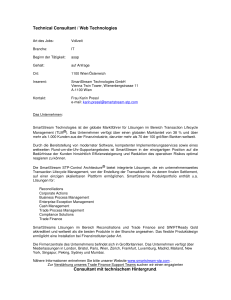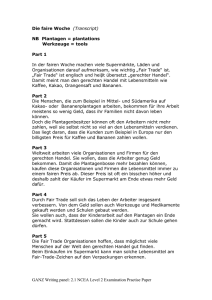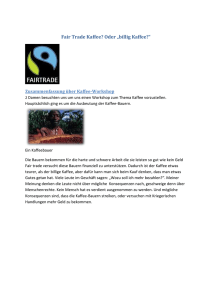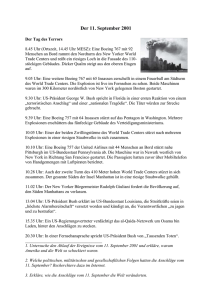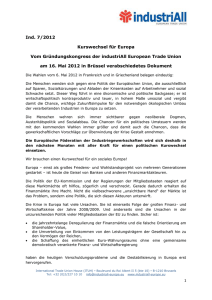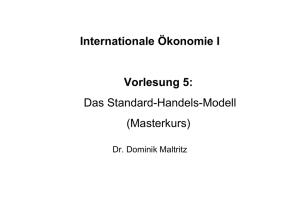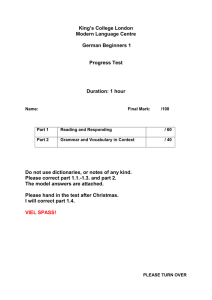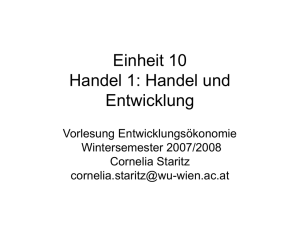2014
Werbung
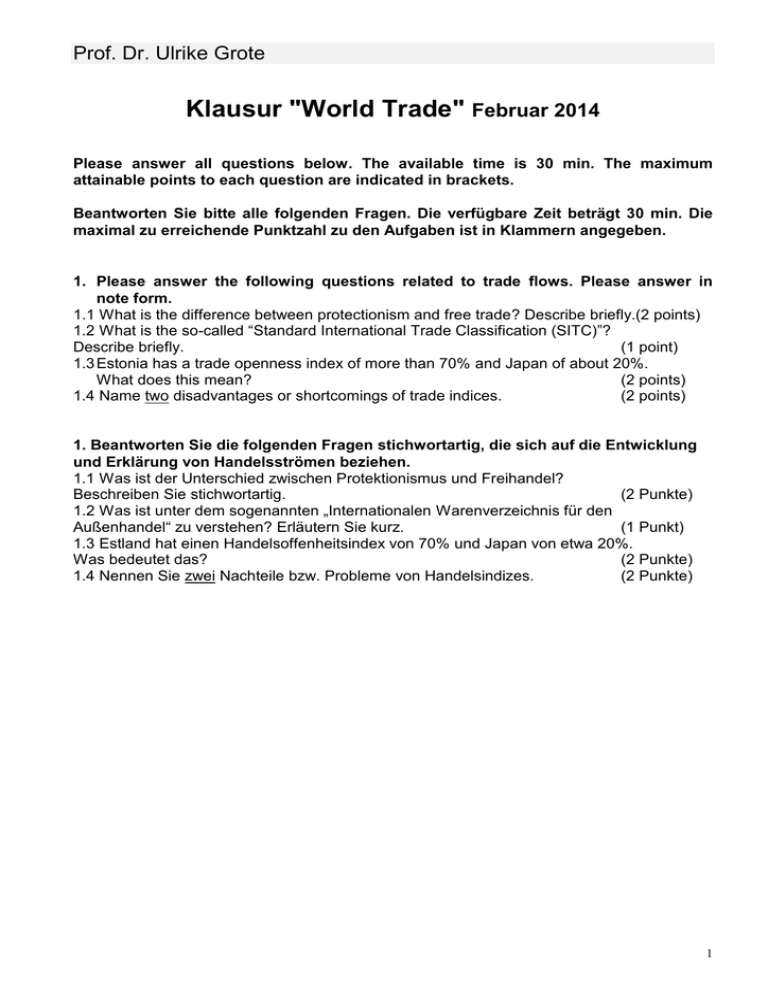
Prof. Dr. Ulrike Grote Klausur "World Trade" Februar 2014 Please answer all questions below. The available time is 30 min. The maximum attainable points to each question are indicated in brackets. Beantworten Sie bitte alle folgenden Fragen. Die verfügbare Zeit beträgt 30 min. Die maximal zu erreichende Punktzahl zu den Aufgaben ist in Klammern angegeben. 1. Please answer the following questions related to trade flows. Please answer in note form. 1.1 What is the difference between protectionism and free trade? Describe briefly.(2 points) 1.2 What is the so-called “Standard International Trade Classification (SITC)”? Describe briefly. (1 point) 1.3 Estonia has a trade openness index of more than 70% and Japan of about 20%. What does this mean? (2 points) 1.4 Name two disadvantages or shortcomings of trade indices. (2 points) 1. Beantworten Sie die folgenden Fragen stichwortartig, die sich auf die Entwicklung und Erklärung von Handelsströmen beziehen. 1.1 Was ist der Unterschied zwischen Protektionismus und Freihandel? Beschreiben Sie stichwortartig. (2 Punkte) 1.2 Was ist unter dem sogenannten „Internationalen Warenverzeichnis für den Außenhandel“ zu verstehen? Erläutern Sie kurz. (1 Punkt) 1.3 Estland hat einen Handelsoffenheitsindex von 70% und Japan von etwa 20%. Was bedeutet das? (2 Punkte) 1.4 Nennen Sie zwei Nachteile bzw. Probleme von Handelsindizes. (2 Punkte) 1 Prof. Dr. Ulrike Grote 2. Please answer the following questions related to trade policy. 2.1 Name one argument for free trade and one against free trade. 2.2 China introduces a tariff on imported cars. What are the resulting welfare effects? Please use graph and table below to show the effects. 2.3 What changes occur if not China, but Malta raises this tariff? Please use graph and table below to show the effects. (2 points) (4 points) (2 points) 2. Bitte beantworten Sie die folgenden Fragen zur Handelspolitik. 2.1 Nennen Sie ein Argument für und ein Argument gegen den Freihandel (2 Punkte) 2.2 China führt einen Zoll auf importierte Autos ein. Welche Wohlfahrtseffekte resultieren? Geben Sie diese bitte im Schaubild und der Tabelle unten an. (4 Punkte) 2.3 Was ändert sich, wenn nicht China, sondern Malta den Zoll erhebt? Geben Sie bitte die Wohlfahrtseffekte im Schaubild und der Tabelle unten an. (2 Punkte) Zu 2.1) Zu 2.2 und 2.3) China p qD Malta p qS qD qS q Wohlfahrtseffekt q China Malta 2 Prof. Dr. Ulrike Grote 3. Trade theory helps to understand the causes and effects of international trade. 3.1 Briefly explain the theories from David Ricardo and Adam Smith based on the table below. (3 points) 3.2 What does the theory from Heckscher-Ohlin mean? (2 points) 3.3 We allow for the movement of labor in the 2 country-graph below. Add the axis-labels and curve labels and indicate what the abbreviations stand for. (2 points) 3.4 What happens if the workers are allowed to move? Name three effects of the factor movements and show the changes in the graph below. (3 points) 3. Handelstheorie hilft, die Ursachen und Wirkungen internationalen Handels zu verstehen. 3.1 Erläutern Sie kurz die Theorien von David Ricardo und Adam Smith anhand der Tabelle unten. (3 Punkte) 3.2 Was besagt die Theorie von Heckscher-Ohlin? Erläutern Sie kurz. (2 Punkte) 3.3 Wir erlauben die Migration von Arbeitskräften in dem 2-Länder-Schaubild unten. Fügen Sie die Achsen- und Kurvenbezeichnungen hinzu und geben Sie an, wofür die Abkürzungen stehen. (2 Punkte) 3.4 Was passiert, wenn die Arbeitskräfte wandern dürfen? Nennen Sie drei Effekte der Faktorbewegungen und zeigen Sie die Veränderungen im Schaubild unten. (3 Punkte) zu 3.1) Deutschland Schweiz Weißwein 4 2 Milch 6 5 3 Prof. Dr. Ulrike Grote zu 3.3 und 3.4) 4 Prof. Dr. Ulrike Grote 4. Please answer the following questions related to trade policy. Please answer in note form. 4.1 Regional trade agreements can take different forms. What is the difference between a customs union and a free trade zone? (2 points) 4.2 What is meant by the term “trade creation”? (1 point) 4.3 What is meant by the term “most favoured nation principle”? (1 point) 4.4 What does the abbreviation “TRIPS” stand for? (1 point) 4. Beantworten Sie bitte die folgenden Fragen stichwortartig zur Handelspolitik. 4.1 Regionale Handelsabkommen können verschiedene Formen annehmen. Was ist der Unterschied zwischen einer Zollunion und einer Freihandelszone? (2 Punkte) 4.2 Was versteht man unter dem Begriff „Handelsschaffung“? (1 Punkt) 4.3 Was ist unter der Meistbegünstigungsklausel zu verstehen? (1 Punkt) 4.4 Wofür steht die Abkürzung „TRIPS“? (1 Punkt) 5
